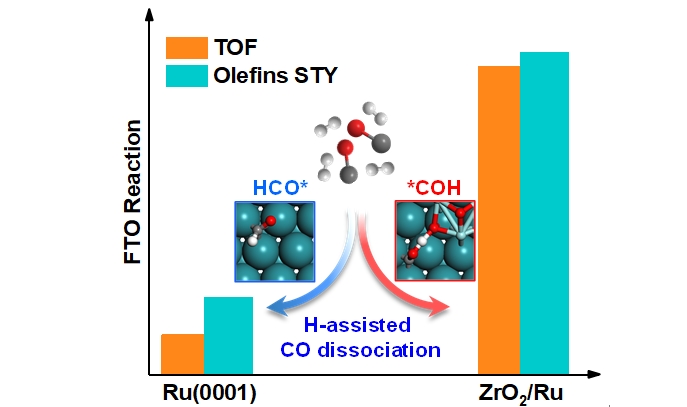Research Progress
Researchers Develop ZrO2–Ru Interface to Boost Fischer-Tropsch Synthesis to Olefins
date:
2024-07-15
Considering the high cost of noble metal Ru, the creation of highly active interfacial sites at low Ru loading is identified as a key scientific challenge for Ru-based Fischer-Tropsch synthesis to olefin (FTO).
A research team led by Profs. ZHONG Liangshu, LIN Tiejun and LI Shenggang from the Shanghai Advanced Research Institute of the Chinese Academy of Sciences have constructed a ZrO2-Ru interface structure, which greatly enhanced the FTO performance.
The work shows that the ZrO2-Ru interface could be engineered by loading the ZrO2 promoter onto silica-supported Ru nanoparticles (ZrRu/SiO2), achieving 7.6 times higher intrinsic activity and ~45% reduction in the apparent activation energy compared with the unpromoted Ru/SiO2 catalyst.
Their pioneering work, published in Nat. Commun., provides the scientific basis for designing highly active, highly selective, highly stable, and economically feasible Ru-based FTO industrial catalysts.
Various characterizations reveal that the highly dispersed ZrO2 promoter strongly binds the Ru nanoparticles to form the Zr-O-Ru interfacial structure, which strengthens the hydrogen spillover effect and serves as a reservoir for active H species by forming Zr-OH* species.
Density functional theory calculations were further employed to investigate the promotional effect of ZrO2 to the Ru catalyst for CO activation and dissociation. The simulations suggest the formation of Zr-OH species at the Zr-O-Ru interface, which results from the barrierless dissociation of H2 molecules and the subsequent migration of the H* adsorbates to the Zr-O-Ru interface with a modest energy barrier.
Furthermore, the calculations also reveal a change of the H-assisted CO dissociation route from the formyl (HCO*) pathway to the hydroxy-methylidyne (COH*) pathway, which significantly reduces the energy barrier of CO dissociation and greatly enhances CO reactivity.
Thus, the much higher FTO activity of the ZrO2-promoted Ru catalyst over the unpromoted Ru catalyst can be attributed to the presence of Zr-OH species at the Zr-O-Ru interface, indicating the importance of the chemical state of the active species on its reactivity.
This work deepens our understanding of the metal-promoter interaction, and shed light on the design of efficient industrial Fisher-Tropsch synthesis catalysts.

Fig.1 Diagram showing CO dissociation mechanism and catalytic performance over Ru and ZrO2/Ru interfacial sites (Image by SARI)





